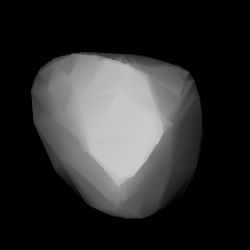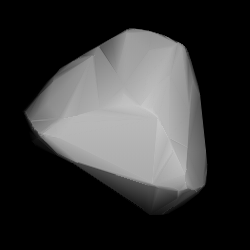Related Research Articles

2829 Bobhope is a dark asteroid of the Meliboea family, from the outer region of the asteroid belt. It was discovered on 9 August 1948, by South African astronomer Ernest Leonard Johnson at Union Observatory in Johannesburg. The asteroid was later named after comedian Bob Hope. The asteroid has a rotation period of 6.1 hours and measures approximately 37 kilometers in diameter.

Stephania is a dark background asteroid from the inner regions of the asteroid belt, approximately 32 km (20 mi) in diameter. It was discovered on 19 May 1881, by Austrian astronomer Johann Palisa at the Vienna Observatory. The C-type asteroid has a rotation period of 18.2 hours. It was named after Princess Stéphanie of Belgium.
Arago, provisional designation 1923 OT, is a dark asteroid from the outer regions of the asteroid belt, approximately 55 kilometers in diameter. It was discovered on 5 September 1923, by Russian astronomer Sergey Belyavsky at the Simeiz Observatory on the Crimean peninsula. The asteroid was named after French mathematician François Arago.
Lagrangea, provisional designation 1923 OU, is a carbonaceous background asteroid from the outer region of the asteroid belt, approximately 30 kilometers in diameter. It was discovered on 12 September 1923, by Russian astronomer Sergey Belyavsky at the Simeiz Observatory on the Crimean peninsula. The asteroid was named after Italian mathematician and astronomer Joseph-Louis Lagrange.
La Paz, provisional designation 1923 PD, is a carbonaceous asteroid from the outer region of the asteroid belt, approximately 40 kilometers in diameter. It was discovered on 31 October 1923, by German astronomer Max Wolf at the Heidelberg-Königstuhl State Observatory and named after the city La Paz in Bolivia.

1039 Sonneberga, provisional designation 1924 TL, is a dark background asteroid, approximately 34 kilometers in diameter, located in the central region of the asteroid belt. It was discovered on 24 November 1924, by German astronomer Max Wolf at Heidelberg Observatory in southwest Germany. The asteroid was named for the German city of Sonneberg, where the Sonneberg Observatory is located.
1178 Irmela, provisional designation 1931 EC, is a stony asteroid from the middle regions of the asteroid belt, approximately 19 kilometers in diameter.
1031 Arctica, provisional designation 1924 RR, is a dark asteroid from the outer region of the asteroid belt, approximately 75 kilometers in diameter. It was discovered on 6 June 1924, by Soviet−Russian astronomer Sergey Belyavsky at Simeiz Observatory on the Crimean peninsula. It was named for the Arctic Sea.
1074 Beljawskya, provisional designation 1925 BE, is a Themistian asteroid from the outer region of the asteroid belt, approximately 48 kilometers in diameter.
1096 Reunerta, provisional designation 1928 OB, is an asteroid from the background population of the asteroid belt's central region, approximately 40 kilometers in diameter. It was discovered on 21 July 1928, by astronomer Harry Edwin Wood at the Union Observatory in Johannesburg, South Africa. The asteroid was named after South African engineer Theodore Reunert, supporter of the observatory and friend of the discoverer.

1165 Imprinetta, provisional designation 1930 HM, is a carbonaceous Meliboean asteroid from the outer regions of the asteroid belt, approximately 49 kilometers (30 mi) in diameter. It was discovered on 24 April 1930 by Dutch astronomer Hendrik van Gent at the Union Observatory in Johannesburg, South Africa. The asteroid was named after Imprinetta Gent, wife of the discoverer.
2038 Bistro, provisional designation 1973 WF, is a stony asteroid from the inner regions of the asteroid belt, approximately 12 kilometers in diameter. The asteroid was discovered on 24 November 1973, by Swiss astronomer Paul Wild at the Zimmerwald Observatory near Bern, Switzerland. It was named for the Bistro restaurant.
1295 Deflotte, provisional designation 1933 WD, is a carbonaceous asteroid from the outer regions of the asteroid belt, approximately 48 kilometers in diameter. It was discovered on 25 November 1933, by French astronomer Louis Boyer at the Algiers Observatory in Algeria, North Africa. The asteroid was named after the discoverer's nephew.

1356 Nyanza, provisional designation 1935 JH, is a dark asteroid from the background population of the outer asteroid belt, approximately 63 kilometers in diameter. It was discovered on 3 May 1935, by South-African astronomer Cyril Jackson at the Union Observatory in Johannesburg. The asteroid was named for the former Nyanza Province in Kenya, Africa.
1258 Sicilia, provisional designation 1932 PG, is a dark background asteroid from the outer regions of the asteroid belt, approximately 44 kilometers in diameter. It was discovered on 8 August 1932, by astronomer Karl Reinmuth at the Heidelberg-Königstuhl State Observatory in southwest Germany. The asteroid was named after the Italian island of Sicily.
1266 Tone is a dark background asteroid from the outer regions of the asteroid belt, approximately 80 kilometers in diameter. Discovered by astronomer Okuro Oikawa at the Tokyo Observatory in 1927, it was assigned the provisional designation 1927 BD. The asteroid was later named after the Tone River, one of Japan's largest rivers.

2120 Tyumenia is a dark background asteroid, approximately 45 kilometers in diameter, located in the outer regions of the asteroid belt. It was discovered on 9 September 1967, by Soviet astronomer Tamara Smirnova at the Crimean Astrophysical Observatory in Nauchnyj, on the Crimean peninsula. The asteroid was named for the now Russian district of Tyumen Oblast in Western Siberia.
1585 Union, provisional designation 1947 RG, is a dark background asteroid from the outer regions of the asteroid belt, approximately 52 kilometers in diameter. It was discovered on 7 September 1947, by South African astronomer Ernest Johnson at the Union Observatory in Johannesburg, South Africa. The asteroid was named after the discovering observatory.
1296 Andrée, provisional designation 1933 WE, is a stony Nysian asteroid from the inner regions of the asteroid belt, approximately 25 kilometers in diameter. It was discovered on 25 November 1933, by French astronomer Louis Boyer at the North African Algiers Observatory, Algeria, and named after the discoverer's niece.
1708 Pólit, provisional designation 1929 XA, is a very dark asteroid from the outer region of the asteroid belt, approximately 29 kilometers in diameter. It was discovered on 30 November 1929, by Spanish astronomer of Catalan origin Josep Comas i Solà at the Fabra Observatory in Barcelona, and was later named after Catalan astronomer Isidre Pòlit i Boixareu.
References
- 1 2 3 4 5 6 7 8 "JPL Small-Body Database Browser: 1952 Hesburgh (1951 JC)" (2017-06-02 last obs.). Jet Propulsion Laboratory . Retrieved 2 July 2017.
- 1 2 3 Schmadel, Lutz D. (2007). "(1952) Hesburgh". Dictionary of Minor Planet Names – (1952) Hesburgh. Springer Berlin Heidelberg. p. 157. doi:10.1007/978-3-540-29925-7_1953. ISBN 978-3-540-00238-3.
- 1 2 3 4 "LCDB Data for (1952) Hesburgh". Asteroid Lightcurve Database (LCDB). Retrieved 5 April 2017.
- 1 2 3 4 Nugent, C. R.; Mainzer, A.; Masiero, J.; Bauer, J.; Cutri, R. M.; Grav, T.; et al. (December 2015). "NEOWISE Reactivation Mission Year One: Preliminary Asteroid Diameters and Albedos". The Astrophysical Journal. 814 (2): 13. arXiv: 1509.02522 . Bibcode:2015ApJ...814..117N. doi:10.1088/0004-637X/814/2/117 . Retrieved 5 April 2017.
- 1 2 3 4 Tedesco, E. F.; Noah, P. V.; Noah, M.; Price, S. D. (October 2004). "IRAS Minor Planet Survey V6.0". NASA Planetary Data System. 12: IRAS-A-FPA-3-RDR-IMPS-V6.0. Bibcode:2004PDSS...12.....T . Retrieved 22 October 2019.
- 1 2 3 Masiero, Joseph R.; Grav, T.; Mainzer, A. K.; Nugent, C. R.; Bauer, J. M.; Stevenson, R.; et al. (August 2014). "Main-belt Asteroids with WISE/NEOWISE: Near-infrared Albedos". The Astrophysical Journal. 791 (2): 11. arXiv: 1406.6645 . Bibcode:2014ApJ...791..121M. doi:10.1088/0004-637X/791/2/121 . Retrieved 5 April 2017.
- 1 2 3 4 Mainzer, A.; Grav, T.; Masiero, J.; Hand, E.; Bauer, J.; Tholen, D.; et al. (November 2011). "NEOWISE Studies of Spectrophotometrically Classified Asteroids: Preliminary Results". The Astrophysical Journal. 741 (2): 25. arXiv: 1109.6407 . Bibcode:2011ApJ...741...90M. doi:10.1088/0004-637X/741/2/90.
- 1 2 3 4 Usui, Fumihiko; Kuroda, Daisuke; Müller, Thomas G.; Hasegawa, Sunao; Ishiguro, Masateru; Ootsubo, Takafumi; et al. (October 2011). "Asteroid Catalog Using Akari: AKARI/IRC Mid-Infrared Asteroid Survey". Publications of the Astronomical Society of Japan. 63 (5): 1117–1138. Bibcode:2011PASJ...63.1117U. doi: 10.1093/pasj/63.5.1117 . (online, AcuA catalog p. 153)
- 1 2 Warner, Brian D. (December 2005). "Asteroid lightcurve analysis at the Palmer Divide Observatory – spring 2005". The Minor Planet Bulletin. 32 (4): 90–92. Bibcode:2005MPBu...32...90W. ISSN 1052-8091 . Retrieved 5 April 2017.
- ↑ Veres, Peter; Jedicke, Robert; Fitzsimmons, Alan; Denneau, Larry; Granvik, Mikael; Bolin, Bryce; et al. (November 2015). "Absolute magnitudes and slope parameters for 250,000 asteroids observed by Pan-STARRS PS1 – Preliminary results". Icarus. 261: 34–47. arXiv: 1506.00762 . Bibcode:2015Icar..261...34V. doi:10.1016/j.icarus.2015.08.007 . Retrieved 5 April 2017.
- 1 2 "1952 Hesburgh (1951 JC)". Minor Planet Center. Retrieved 5 April 2017.
- ↑ "MPC/MPO/MPS Archive". Minor Planet Center. Retrieved 5 April 2017.